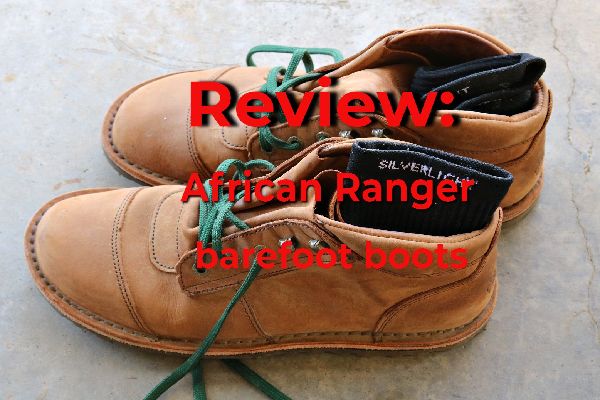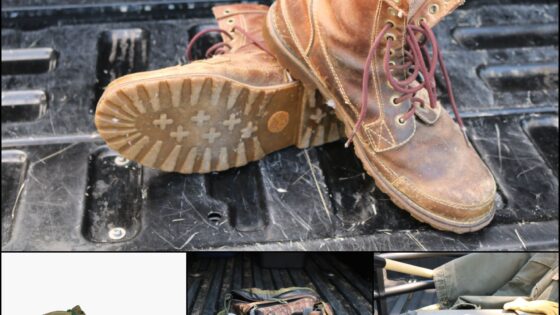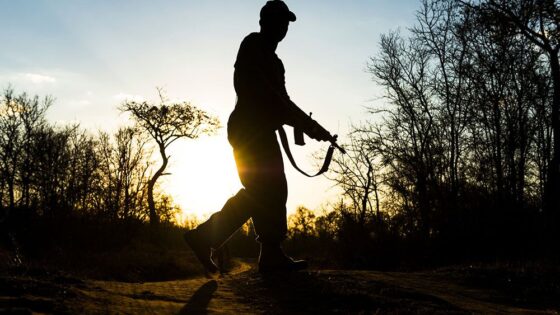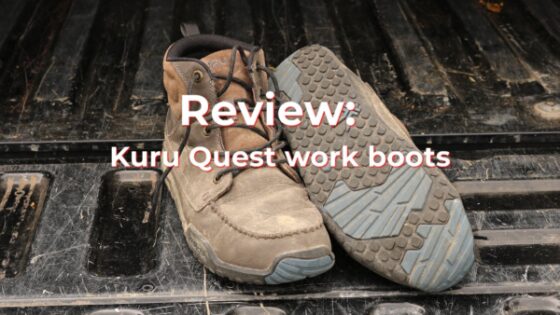The popular Jim Green Ranger Boots have a new configuration that makes them available as “barefoot” shoes. Is this a big deal?
by Leon Pantenburg
Barefoot boots have become a “thing.” The concept is that barefoot shoes/boots allow the foot to react to the ground as it would if the walker was walking barefoot. This strengthens muscles in the feet, bare foot proponents claim, which may have become weakened because of years of wearing shoes. Going barefoot allows the legs and spine to align naturally, proponents further claim, reducing or eliminating back aches, joint issues and other posture-related problems.
So how much is hype, and how do these barefoot boots work out? A barefoot boot will have a zero drop sole. That means there is no height difference from the heel to the toe. (

The Jim Green barefoot boots (top) have a similar upper to the standard African Rangers. Bottom left, the barefoot sole has a different pattern from the standards. Bottom right: The standard Rangers have a heel rise.
I like barefooting in specific instances. I walk with my Lab Naga a minimum of two miles every evening, year-round. In the summer, I typically walk barefoot on a concrete/asphalt oval track near my home. If the pavement is too (Mississippi summer) hot for my bare feet, then it is too hot for my dog. A pair of flip-flops are along for rough spots on the route. Naga always has the choice of running in the grass next to the track. I never go barefoot in the woods, desert or off a beaten path. Nobody can toughen up their feet enough to survive a broken beer bottle!
There are other barefoot boots in my shoe closet, including the excellent Lem’s Boulder Boots. I like the zero drop, and find the boots to be very comfortable. My favorite Kuru Atoms running shoes have a heel-to-toe drop of eight millimeters, or 5/16-inch.)
My appreciation of the Jim Green Ranger boots is well documented. Except for the heel to toe drop, the Ranger boots and the Ranger Barefoot boots are very similar.
Here are the Barefoot boot specs:
-
The boot is designed with three main focus areas: Comfort and Durability at an affordable price.
-
The wedge sole is designed to grip while the softer rubber compound keeps the Ranger quiet when walking through the African bush.
-
Toe, Heel and Eyelet area manufactured with a double layer of 2.2mm full grain leather for added durability.
-
Heel and Toe stiffeners for added durability, support and protection.
-
Soft leather collar and tongue for comfort and weight reduction
-
Insole is secured to the upper with a double stitched 2.2mm braided nylon cord.
-
Can be resoled – stitch down construction. (All specs are courtesy of Jim Green website.)
Here is how they worked out:
Comfort: Like the first pair of Jim Greens I tried out, these barefoot boots were comfortable from the get-go. I put them on over a pair of wool socks, and walked two miles. Nothing. No rubbing, chaffing or discomfort. Since I frequently go barefoot, I didn’t have any discomfort associated with transitioning to barefoot shoes from regular heeled shoes.
While break-in time was short, it can’t be ignored! NEVER think you can break in a new pair of boots on the trail. I require
Soft leather collar and tongue: Outstanding. This combination eliminated any potential discomfort on the arch or around the ankle. The collar tightens down to keep trail debris from getting kicked into the back of the boot.
Full grain leather: This material is the best choice, IMHO, for a boot upper that needs to last. The rangers must depend on a boot that won’t fail during a long patrol or in rugged terrain.
Sole: Composed of a soft rubber compound, the Barefoot sole has a different pattern than that of the Rangers. It is reenforced at the toe and heel for longer wear. This is not a mountaineering tread, but it will do very well for the great majority of hiking. I like the fact that it is easy to clean – this becomes a big deal on a work boot when you are going in and out of the house from the truck.

The tread pattern is great for most everyday wear.
Wide width: I have EE-wide feet, and these boots come in a wide width that is perfect for my feet. I can wiggle my toes easily inside the boots, and there is ample room for thick socks. Carry a heavy pack, and you’ll appreciate the width as your feet flatten out from the weight. Here is how to make sure your boots fit correctly.
Do you need a pair of Jim Green Barefoot Boots?
If you’re thinking or trying out barefoot boots, these Jim Greens are a good choice. They have a great sole, sure, but the rest of the boot is time-tested and proven in the field, under the most extreme conditions. The combination of a good design, outstanding workmanship and quality components makes footwear hat can be depended upon.
I like my Jim Green Barefoot Boots and wear them a lot. They are an excellent entry into the barefoot footwear world.
There are a lot of factors that determine how comfortable your hiking footwear will be. Consider these things when you are shopping:
- Shoes or boots for hiking?
- Waterproof or not?
- What are the best socks for the conditions?
- How do you avoid getting sore feet?
- Will the shoes or boots keep your feet warm?
- Make sure your boots fit correctly.
Please click here to check out and subscribe to the SurvivalCommonSense.com YouTube channel – thanks!
For more survival information, please check out my book “Bushcraft Basics.”






Leave a Reply